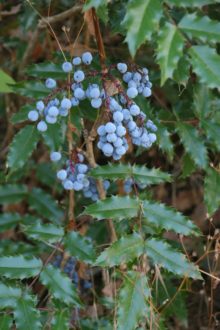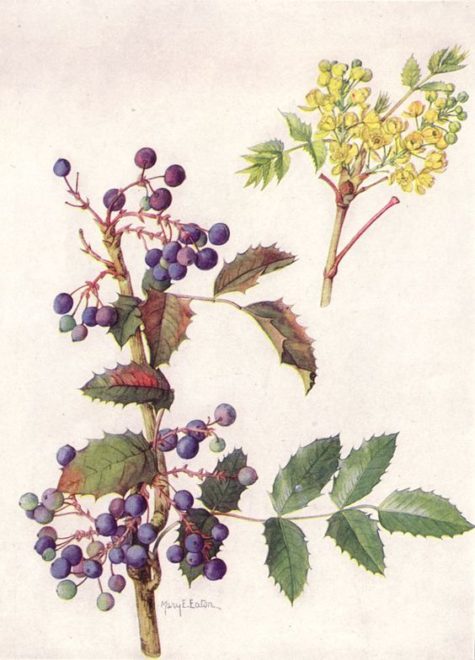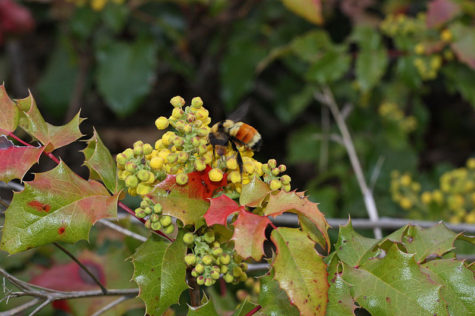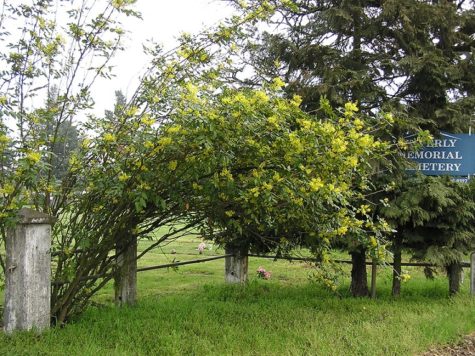Oregon Grape
- Scientific Name: Berberis Aquifolium
- Common Name: Barberry
- Plant Family: Berberidaceae
- Parts Used: Rhizome and Roots, Bark, Fruits
- Actions: Alterative, cholagogue, diuretic, laxative and tonic
Description:
Several varieties of the subgenus Mahonia contribute to the drug of commerce under the name of Berberis aquifolium. It is a quickly-growing shrub about 6 feet high: the oddly compound leaves have no spine at the base; they are evergreen and shining. The flowers grow in terminal racemes, are small and yellowish-green in color, and the purple berries are three- to nine-seeded. The bark is brown on the surface and yellow beneath. The root is from 1/2 inch in diameter to 3 inches at the base of the stem, odorless, and with a bitter taste. The shrub was introduced into England from North America in 1823. It was formerly known as Mahonia aquifolia and is very hardy.
Note:It should not be used with Glycyrrhiza species (Liquorice) because this nullifies the effects of the berberine.
The Basics:
Oregon grape was often used by several native North American Indian tribes to treat loss of appetite and debility. Its current herbal use is mainly in the treatment of gastritis and general digestive weakness, to stimulate the kidney and gallbladder function and to reduce catarrhal problems. The root and root bark is alterative, blood tonic, cholagogue, diuretic, laxative and tonic. It improves the digestion and absorption and is taken internally in the treatment of psoriasis, syphilis, haemorrhages, stomach complaints and impure blood conditions. Externally, it has been used as a gargle for sore throats and as a wash for blurry or bloodshot eyes.
The blue fruits are tart and improve after frost. They are often gathered for jelly or wine. Used to treat a wide variety of ailments, Oregon Grape species contain the extremely potent alkaloid, berberine, (also found in goldenseal) which is antiseptic and stimulates the liver and spleen.
The fruit is an excellent gentle and safe laxative. Berberine, universally present in rhizomes of Mahonia species, has marked antibacterial effects and is used as a bitter tonic. Since it is not appreciably absorbed by the body, it is used orally in the treatment of various enteric infections, especially bacterial dysentery.
Berberine has also shown anti-tumor activity.
It is one of the best alterative blood purifiers and liver stimulants. Uses for the Oregon Grape Root include weak digestion, flatulence, jaundice, blood impurities, and as a general tonic to the whole system.
A decoction (instructions below) will be found to be a wonderful blood purifier and will restore health to many who are suffering from a sluggish liver, weak stomach, indigestion, and sallow skin.
Years ago, it was given to children, and said to create appetite and promote digestion, and increase strength and vitality. The current medical thinking is that it is not safe for children, especially infants, or pregnant or nursing women. (see information at the bottom of the post)
Habitat and Cultivation:
Grows along the western coast of the United States and in the Rocky Mountains. It can be found in mixed coniferous woods to 6000 feet. It is also found in woods and hedgerows in Britain.
Seed is best sown as soon as it is ripe in a cold frame. It usually germinates in the spring. “Green” seed (harvested when the embryo has fully developed but before the seed case has dried) should be sown as soon as it is harvested and germinates within 6 weeks. Stored seed should be sown as soon as possible in late winter or spring. 3 weeks cold stratification will improve its germination, which should take place in 3 – 6 months at 10C. Prick out the seedlings when they are large enough to handle and grow them on in a cold frame for at least their first winter. Plant them out in late spring or early summer.
Division of suckers in spring is another method of cultivation. While they can be placed direct into their permanent positions, better results are achieved if they are potted up and placed in a frame until established. Leaf cuttings can be taken in the autumn.
Collection:
- Roots: The roots are best harvested in late autumn and dried for later use. If you are digging the rhizomes and roots, wash to remove dirt, then strip larger ones with a knife. Entire smaller roots can be cut with pruning sheers or scissors. Dry in baskets or paper bags. They will last 1-2 years.
- Flowers: Picked as they bloom.
- Berries: Collected when ripe, the flavor improves after frost.
- Bark: Strip the bark with a sharp knife when it is fresh. As it dries it gets surprisingly tough to scrape. This is the easiest method of collection – no digging or washing necessary. Dry in baskets or paper bags. They will last 1-2 years.
When tested, the berberine content (an alkaloid that has potent medicinal properties) of the tall Oregon Grape stem was slightly higher in berberine than the dwarf Oregon grape root.
Medicinal Uses:
Oregon grape is used for stomach ulcers, gastroesophageal reflux disease (GERD), stomach upset, as a bitter tonic, to treat infections, and to cleanse the bowels. Oregon grape is applied to the skin for a skin disorder called psoriasis and as a disinfectant. How does it work? The chemicals in Oregon grape might help fight bacterial and fungal infections. Oregon grape may also slow the overproduction of skin cells in diseases such as psoriasis.
Some evidence suggests that applying a specific 10% Oregon grape extract cream (Relieva by Apollo Pharmaceutical) can reduce the severity of psoriasis and improve quality of life for people who have psoriasis. It might be as effective as the medicationcalcipotriene (Dovonex) cream for some people.
Tonic and alterative, recommended in psoriasis, syphilis and impure blood-conditions. It may be used like colombo, berberis, etc., in dyspepsia and chronic mucous complaints. In constipation it is combined with Cascara Sagrada. It improves digestion and absorption.
It is also used as a homeopathic remedy for the skin issues, chronic catarrhal affections, secondary syphilis; hepatic torpor, lassitude and other evidences of incomplete metamorphosis; stimulates all glands and improves nutrition.
Oregon grape can be used both externally and internally to fight bacterial infections. For wounds, you can either make a strong tea and soak the wound in it, or you can saturate a dry sterile bandage or very clean cloth in the tea, then secure it on the wound. You can also power the dried root and sprinkle it directly on wounds. Oregon grape has been used successfully for intestinal infections. It is specific against salmonella, shigellosis and amebic dysentery. It is also useful for an upset stomach due to something you may have eaten that “seemed a little off.”
The bitterness of Oregon grape is valuable in itself. As bitter compounds touch your taste buds on your tongue they send messages to your brain – causing an increase in many digestive secretions including saliva, hydrochloric acid, pepsinogen and hormones that stimulate the gall bladder and pancreas. This, of course, leads to better and more efficient digestion down the digestive tract. Try Oregon grape tea or tincture before meals as a bitter tonic to prevent indigestion. Because it stimulates digestive juices, it also acts as a laxative.
Oregon grape stimulates liver function. Many Americans have a pattern of liver deficiency. The liver is responsible for many functions including:
- Breaking down metabolites and toxins
- Producing bile, which helps break down fats and proteins, and acts as a laxative
- Working with other organs to balance blood sugar
- Making high quality building blocks to support the skin and other tissue
Here is the common picture of some of the symptoms that might emerge when a person’s liver is not functioning optimally: dry and cracked skin with slow healing wounds, gum problems and dry mouth, regular indigestion and perhaps constipation, a white or yellow coated tongue with bad breath in the a.m., difficulty digesting fats and proteins, rapid shifts in blood sugar levels and a preference for sweets and light foods or environmental allergies. If this picture sounds familiar, Oregon grape may be a plant for you!
From 1896, we have this description of the medical uses of Oregon Grape Root:
Owing to its remarkable power over mucous structures we would suggest its employment in gastric and intestinal catarrh. The principal uses of this drug have been developed by Dr. J. H. Bundy and Prof. Herbert T. Webster. The dose of berberis aquifolium should be relatively large. Small doses, as required of most of our important agents, do but little good.
This agent has justly been extolled as an alterative and tonic, and has been recommended in syphilitic affections, salt-rheum, pityriasis, psoriasis, and other cutaneous affections, as well as in maladies supposed to be due to some mal-condition of the blood. Excretion and secretion are promoted by it; digestion and assimilation improved; the lymphatic glandular system and the ductless glands are stimulated; and the renal secretions somewhat augmented. Thus it acts as a blood-maker, and is therefore a remedy to oppose depraved conditions of the body-fluids.
As a tonic, it may be employed as a synonym of hydrastis, colombo, berberis, etc., possessing in addition its own peculiar virtues, in dyspeptic conditions, chronic mucous maladies, and in certain enfeebled conditions of the system, etc. Owing to its invigorating power over the gastric functions, it is a valuable remedy for atonic dyspepsia, and more particularly if associated with hepatic torpor, for which it is also an excellent remedy. A cirrhotic liver, associated with gastro-enteritis, has been benefited by it, and for chronic constipation it is a useful agent when combined with cascara sagrada. It is said to be effectual in stomatitis.
The great field for berberis aquifolium is in constitutional syphilis and its manifold complications and sequelae. The disorders named above are more amenable to this drug when associated with a syphilitic taint than otherwise. If given early enough it will prevent tertiary phases, provided the patient has not been too thoroughly mercurialized. Its use must be prolonged in appreciable doses. It is especially adapted to long-standing cases of syphilis, the older the better, according to some of its advocates, and yet it is a remedy of much value all through the course of the disease. It is the remedy for that broken-down state so frequently following in the wake of that malady. The various eruptions give way to it, the gastric complications are subdued, and the mucous membranes are toned so that excessive secretions are restrained.
The bone and periosteal, as well as the muscular, pains of syphilitics, are amenable to berberis. Its action is slow but sure, as it is also in severe muscular pains, with partial paralysis, due to spinal disease. Long standing syphilitic phagadenae and herpetic and eczematous states, yield to it better than to most agents. It should not be forgotten in syphilitic anemia. Several stubborn cases of psoriasis have been cured by it, and it is a valuable drug in erysipelatous and chronic scrofulous affections. While it has failed to cure carcinoma, as its introducer, Dr. J. H. Bundy, believed it would, it has, however, shown itself of value in the dyscrasiae due to a cancerous cachexia.
Preparation and Dosage:
Decoction: Put 2 ounces of Oregon Grape Root (cut into pieces) into 1 quart of distilled water. Boil slowly in a covered saucepan for 20 minutes. Strain through a cloth and when cool, bottle and keep in a cold place.
Dosage for the decoction: One wine glassful three times a day, one hour before meals. If it relaxes the bowels too much, reduce the dose, but take regularly. For children, the dose is one teaspoonful to one dessert spoonful in honey water.
Fluid Extract: The dose of the fluid extract is from 10 to 20 drops every 3 or 4 hours; of specific berberis aquifolium 5, 10 or 15 drops, every 3 or 4 hours.
Tea: Use about 2 teaspoons of dried cut bark/root or 1 teaspoon of the powder per cup of boiling water. Place the herb and water in a pot, bring to a boil, turn down, cover with a lid and simmer for 15 minutes. Stain. Drink ½ cup 2-3 times a day. If you are using fresh bark, use 1 tablespoon of per cup and boil 15 minutes.
Alcohol Tincture: Because Oregon grape tastes so bitter many people prefer to take it as a tincture. Tinctures are easy to use and will last for 7-9 years. They are not appropriate for people with alcohol issues. To make tincture, finely chop bark/roots, then weigh them with a scale. For every 1 part herb by weight, use 2 parts alcohol by volume (you can use 80-100 proof vodka or brandy).
For example, if you have 3 ounces of herb, you will use 6 ounces of alcohol.
Place the Oregon grape and alcohol in a glass mason jar and cover with a tight fitting lid. Let sit for at least 2 weeks, stirring occasionally, then strain with muslin cloth. Make sure to squeeze out as much liquid as you can. Compost the herb. Place the tincture in a glass bottle for storage. Amber dropper bottles work well because you can easily determine a drop dose. The dosage is 30-45 drops 2-3 times a day.
Dry herb tincture: can be made by mixing 1 part dried herb by weight with 5 parts alcohol by volume. Follow directions as above.
Contraindications: Oregon grape should not be used for people with liver excess symptoms including a pointed, red tipped tongue, excess salivation and frequent loose stools.
As a food source:
 Fruit can be eaten raw or cooked. The fruit is almost as large as a blackcurrant and is produced in large bunches so it is easy to harvest. It has an acid flavor, but it is rather nice raw and is especially good when added to a porridge or muesli. Unfortunately, there is relatively little flesh and a lot of seeds, though some plants have larger and juicier fruits. The cooked fruit tastes somewhat like blackcurrants. The fruit can also be dried and stored for later use.
Fruit can be eaten raw or cooked. The fruit is almost as large as a blackcurrant and is produced in large bunches so it is easy to harvest. It has an acid flavor, but it is rather nice raw and is especially good when added to a porridge or muesli. Unfortunately, there is relatively little flesh and a lot of seeds, though some plants have larger and juicier fruits. The cooked fruit tastes somewhat like blackcurrants. The fruit can also be dried and stored for later use.
Oregon grape berries are REALLY tart – the kind of tart that makes your face twist and your eyebrows lift beyond known measure. But, when mixed with sweetener, they are really delicious. In the same way that fine wine carries complex flavors, Oregon grape is earthy and rich with undertones of cherry, raspberry and lemon.
Oregon grape berries are a traditional food for Northwest Native People and were often mixed with other sweeter berries like salal and made into pemmican cakes. A few years ago I heard about 2 hikers who got lost in the woods for over a week. The only edible food they knew was Oregon grape berries and they ate them in large quantities. They came back in fine shape. Hopefully you, dear reader, will have a greater variety of foods in your knowledge basket when you brave the wild. (source)
Oregon grape juice can be fermented to make wine, similar to European barberry wine folk traditions, although it requires an unusually high amount of sugar.
Flowers can be eaten raw. They can also be used to make a lemonade-like drink.
The young leaves can be eaten. And when I say young I mean it! The older leaves become very tough and quite spiky. The young tender leaves have a slightly sour taste reminiscent of a citrus fruit.
Common Names:
- Mahonia aquifolia.
- Holly-leaved Barberry.
- Rocky Mountain Grape.
- California Barberry.
- Trailing Mahonia.
Other Uses:
A yellow dye is obtained from the inner bark of the stem and roots. It is green according to another report. Dark green, violet and dark blue-purple dyes are obtained from the fruit. A green dye is obtained from the leaves. This species can be grown as a low hedge and does not need trimming. Because of its suckering habit, it also makes a good dense ground cover plant though it can be slow to become established.
Special Precautions and Warnings:
Oregon grape cream is POSSIBLY SAFE for most people when applied directly to the skin. It can cause some side effects such as itching, burning, irritation, and allergic reactions.
There is not enough information to know if Oregon grape is safe when taken by mouth in medicinal amounts.
Drug Interactions:
Cyclosporine (Neoral, Sandimmune) interacts with OREGON GRAPE
The body breaks down cyclosporine (Neoral, Sandimmune) to get rid of it. Oregon grape might decrease how fast the body breaks down cyclosporine (Neoral, Sandimmune). This might cause there to be too much cyclosporine (Neoral, Sandimmune) in the body and potentially cause side effects.
Medications changed by the liver (Cytochrome P450 3A4 (CYP3A4) substrates) interacts with OREGON GRAPE
Oregon grape might decrease how quickly the liver breaks down some medications. Taking Oregon grape along with some medications that are broken down by the liver can increase the effects and side effects of some medications. Before taking Oregon grape, talk to your healthcare provider if you are taking any medications that are changed by the liver.
Some medications changed by the liver include cyclosporine (Neoral, Sandimmune), lovastatin (Mevacor), clarithromycin (Biaxin), indinavir (Crixivan), sildenafil (Viagra), triazolam (Halcion), and many others.
Pregnancy and breast-feeding: Pregnancy and breast-feeding: It’s LIKELY UNSAFE to use Oregon grape if you are pregnant. One of the chemicals in Oregon grape, berberine, may cross the placenta and might cause harm to the fetus. Brain damage (kernicterus) has been reported in newborn infants exposed to berberine. Berberine can also be transferred to the infant through breast milk. It’s also LIKELY UNSAFE to use Oregon grape if you are breast-feeding due to the berberine in Oregon grape.
Children: It’s LIKELY UNSAFE to give Oregon grape to children, especially newborns. The berberine in Oregon grape can cause brain damage (kernicterus) in newborns, particularly premature newborns who have jaundice. Jaundice is a condition in which there is yellowing of the eyes and skin caused by bile pigments in the blood. It can happen in newborns who have a different blood type than their mother.
Recipes and Formulas:
Rennie Luttrull: queen-annes-lace-seeds
Rosanna: Spignel aka Bald Money
Annamarie Squatrito: Fumitory
EILEEN Klinghagen: Pumpkin
Mahmudul Hasan: Celery





Leave a Reply